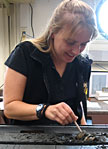| Research
|
|
|||||||||||||||||||||||||||
|
Check out the joint Fermilab/SLAC publication symmetry.
|
DNA repair: A maternal mechanismOnce again, here is something to blame on moms: research published in a recent issue of the Proceedings of the National Academies of Sciences shows that maternal DNA-repair capability is responsible for repairing DNA damage in the fertilizing sperm and embryos with improperly repaired DNA die early in development or are born with defective chromosomes. The research in mice, in which specific DNA-repair genes were missing, was conducted at DOE's Lawrence Livermore National Laboratory by biomedical scientists Francesco Marchetti and Andrew Wyrobek, now researchers at Lawrence Berkeley National Laboratory. Marchetti said he was surprised by the degree to which the effect occurred. In the most extreme case in mice of the scid line, which are missing an important DNA repair enzyme, developing zygotes (fertilized eggs) possessed twice as many chromosomal aberrations. Marchetti and colleagues hypothesized that when developing sperm are exposed to a mutating agent, damaged DNA in the fertilizing sperm is converted into chromosomal aberrations in embryos unless the anomalies are repaired soon after fertilization. They tested their hunch by exposing the male mice to ionizing radiation, which tends to break double-stranded DNA, seven days before the mice were mated. Eggs provide essentially all the cellular machinery for the developing zygote, since mature sperm consist of little more than a packet of chromosomal material. This machinery includes DNA repair enzymes, which spot and fix errors such as breaks in the strand of genetic material. Previously, the maternal mechanism responsible for preventing aberrations in the fertilizing sperm had not been pinpointed, Wyrobek said. In the mouse, the maternal DNA repair enzymes function in the fertilized egg until it has reached a two-cell stage and the zygote's gene activity takes over, creating its own array of cellular functions. This transition occurs at a slightly later stage in humans. While some variation derived from mutation may confer traits that enhance adaptation of the offspring, in most cases a new mutation is associated with pregnancy loss, developmental defects, infant mortality, infertility and genetic diseases in the offspring. Mutations may be transmitted by either parent. The types attributed to a mix-up in the original DNA sequence, possibly caused by faulty repair, are more frequently traced to the father's sperm. Despite the news that DNA repair function in the egg is crucial just after fertilization, Marchetti said, the results also underscore that men who are intending to start families can take care to avoid exposures that might damage DNA in developing sperm. For example, he said there is growing evidence that DNA damage in sperm is elevated in men who smoke cigarettes, which can be avoided.Submitted by DOE's
Lawrence Livermore |





